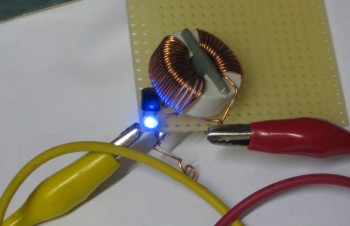
A joule thief circuit lit from a 0.5V AAA battery. Click to enlarge.
A Joule thief is a simple circuit that acts as a DC to DC booster, raising a supply voltage by several volts. In this iteration it uses the exhausted voltage of a alkaline battery and boosts it enough to light a blue LED that requires 2.8V to light. With an otherwise dead 0.5V AAA battery, it will light a blue LED and run for days, using (at the moment) just under 2mA of current. It's much much dimmer than using a fresh battery or running the LED with a proper current through it. Giving the Joule thief circuit 3V from two fresh batteries pulls 75mA through the LED, making it very, very bright and probably short-lived.
A schematic is below. The circuit works like this: When first turned on, current flows into the inductor and produces a magnetic field in the toroid. While this is happening, no voltage appears at the base of the transistor, so the transistor remains off. The LED sees at first no voltage and while the inductor fills up, it only sees a maximum voltage of the battery, which is not enough to pass the diode. Once the inductor is charged, the battery voltage appears at the base of the transistor, turning it on. This allows the right side of the inductor to want to dump the energy it has stored in its magnetic field as quickly as possible, and this gives us a high-voltage that appears across the inductor. When that voltage exceeds 2.8V the LED turns on and lights up until the voltage drops below, triggering the sequence to begin again. I measured the frequency of the on/off oscillation and it seems to run at about 34kHz; the multimeter said between 68 and 72kHz but a radio showed there was 34kHz signal as well, which I assume was the fundamental (and the 68kHz one a harmonic). It did change in frequency a bit while on.
 Bre Pettis/Windell Oskay
Bre Pettis/Windell Oskay
11 comments:
how many wires???????
Since I tied the leads of the ferrite, LED, and transistor together for connection points, I only used two wires to connect to the battery.
Hi Dean,
What would you suggest for the torroid windings to convert/boost 2.4v to 5v?
Thanks!
Mark
I would bet the output would be well over 5V if you gave this circuit 2.4V. But I'm betting you are looking for something more regulated.
http://www.ladyada.net/make/mintyboost/process.html
hi Sir
i want to boost up +12v dc 36A into +15v dc 10A
can you please suggest me any circuit.....
how can i convert it to 9v?
Hello Kiran, this circuit is so simple it is hard to say what the output voltage is; it is best to either control it after the boost with a standard regulator (like a LM317) or to use a standard DC-to-DC converter chip in the first place to set it to 9V DC.
My Greetings to You
I Startpaged "how to raise dc voltage" and found here a likely step in the right direction:
My son and I are building a "potato cannon", commonly powered w/propane-air; however we intend to use O2 and acetylene. So the combustion chamber is 22" x 3" sch 40 pipe w/ NPT barrel port, 2 NPT valve ports, & a 14 x 1.25mm port for an automotive spark plug. Currently 2 sch 40 NPT 1" ID Barrels; 1 stubby for testing & 1@ 6' L.
Currently operational w/propane-air
BUT NEED BETTER SPARK!
Started ignition system w/piezo propane barbecue ignitor which rarely worked, so modified an AA battery powered bug zapper-racquet which reliably sparks the plug with a tight gap...
BUT SURE WOULD LIKE A WIIDE GAP and BRIGHT SPARK!
Do you think your Joule Thief could substantially raise the bug zapper output voltage and provide a long bright spark?
I can obtain parts from Mouser Electronics, if I know approximately what to get...
Your thoughts on the matter would be greatly appreciated!
... got it figured out...
there's several joule thief vids on youtube
Came up w/the parts from the pcb in an old, dead VCR. Will assemble & test tomorrow. The transistor (Matsushita NPN C4953) has a package breakdown voltage rating of >5kV so it should be ok w/bug zapper output as supply for joule thief
2013 looks to be auspicious
Put pulses of lowish voltage AC or DC into a step-up transformer (ideally a flyback transformer) and you will get the high voltage you want.
jole thife is nice circuit the magic circuits ralle
Post a Comment